私聊我拉你进群交流
一 模型介绍
yoloV5主要是用于目标的检测,针对检测过程中,一些关键点的输出也是至关重要,其中有yolo-face等目标检测+关键点模型,但是目前所有模型都是单分类+关键点的检测,为了设置多分类+关键点检测,这里我在使用单分类+关键点(yolov5-car-plate)的代码基础上进行修改,实现多分类+关键点检测。
二 模型修改
1 数据代码修改
数据代码修改主要是在 utils/plate_datasets.py 代码下
- 读取数据部分 首先修改 LoadImagesAndLabels 类中方法,添加426行代码
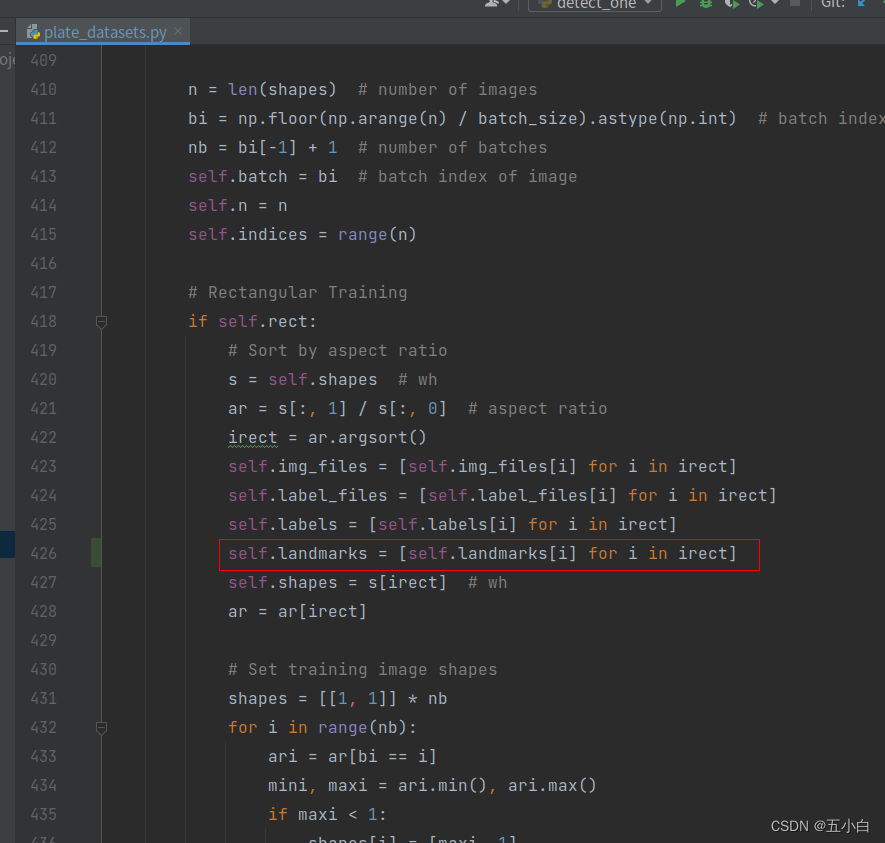
读取数据报错,做如下修改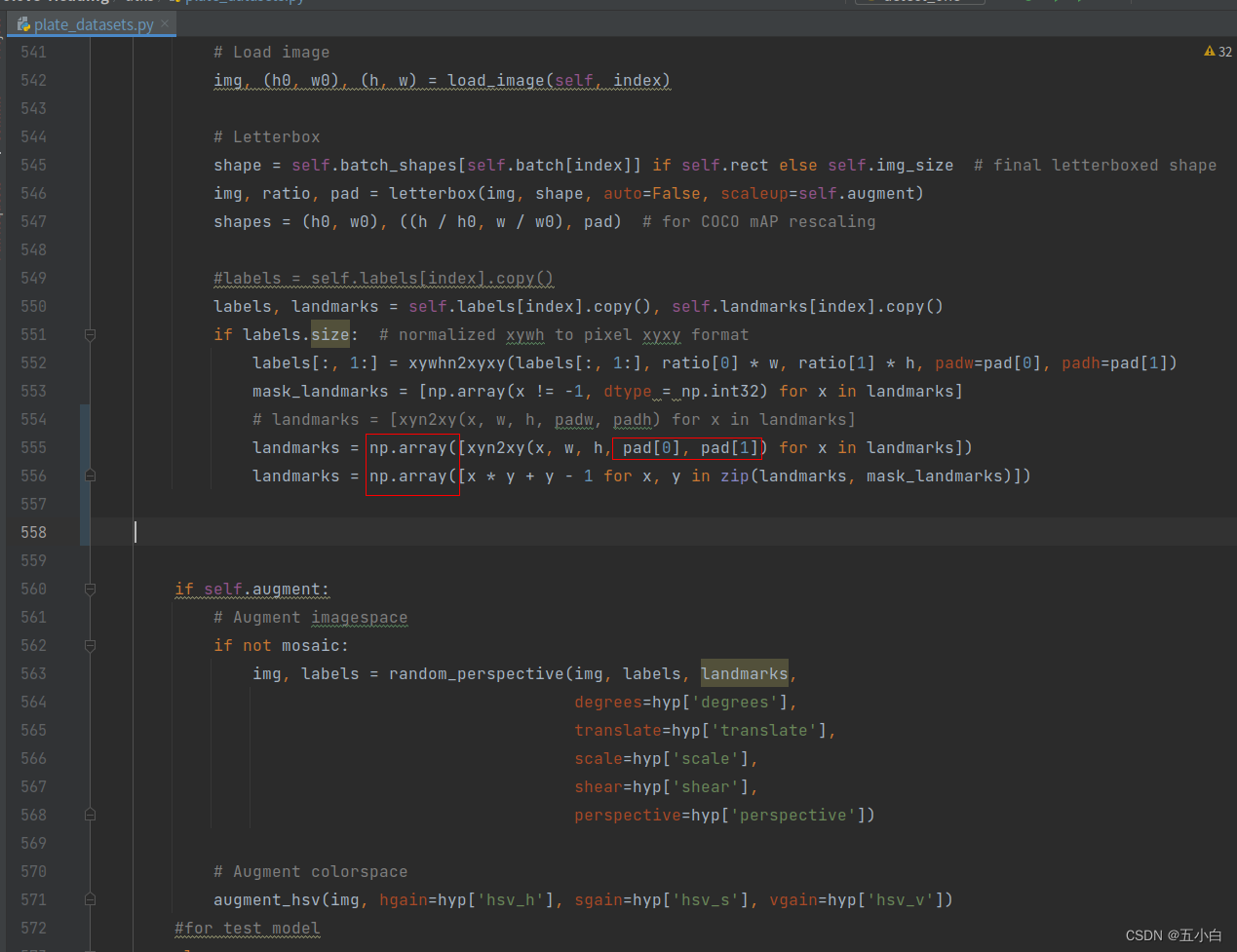
按照制作数据进行依次修改读取数据代码: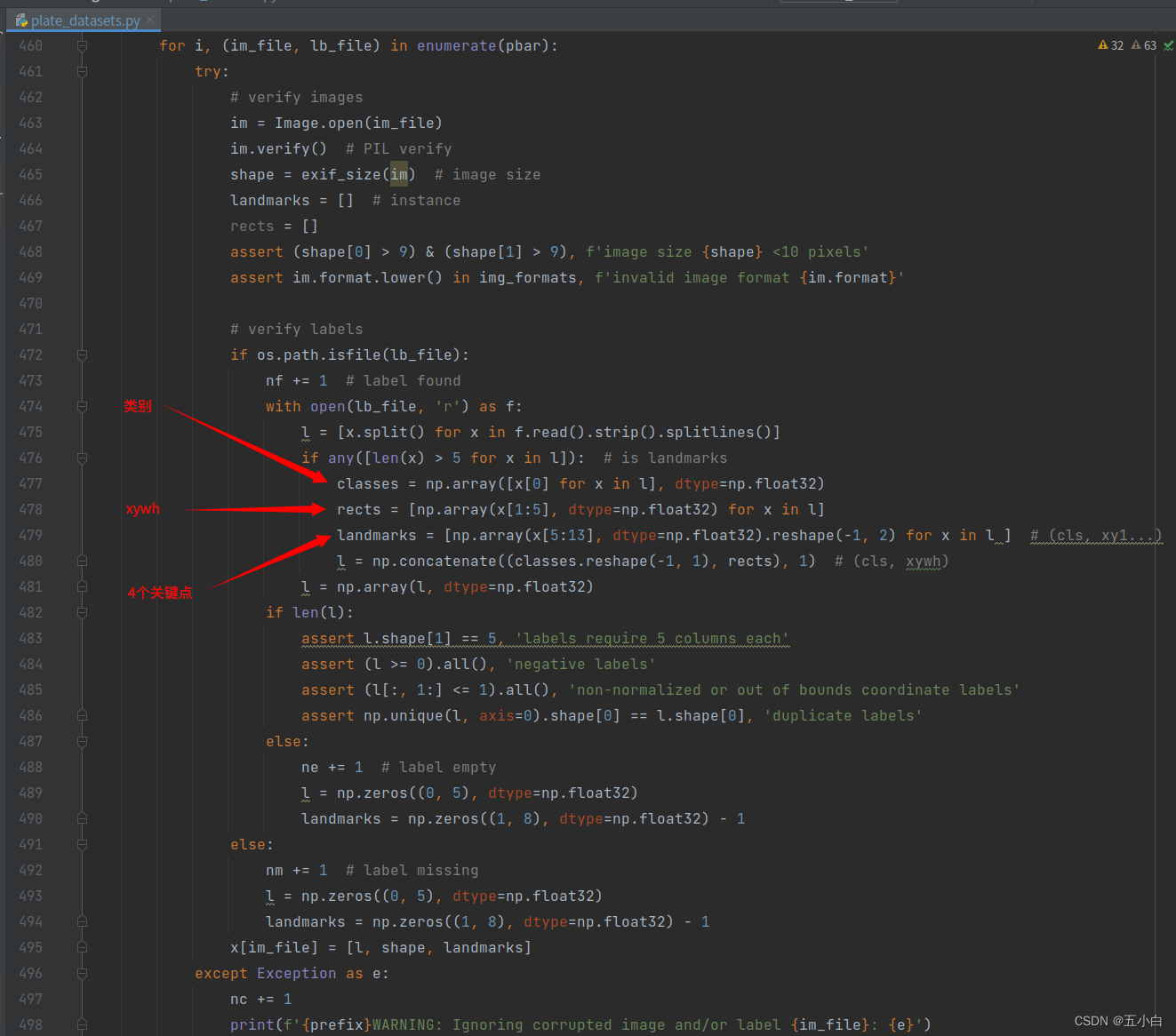
由于我自己的数据标签依次是 :
class,x , y ,w,h, x1 ,y1, x2, y2, x3, y3, x4, y4
所以这部分是没有修改的,这里根据自己的关键点数量进行修改。
数据示例:
- 数据增强-马赛克增强 我自己的数据和作者数据是一样的4个点,所以马赛克增强也是一样的,大家根据自己的点进行修改
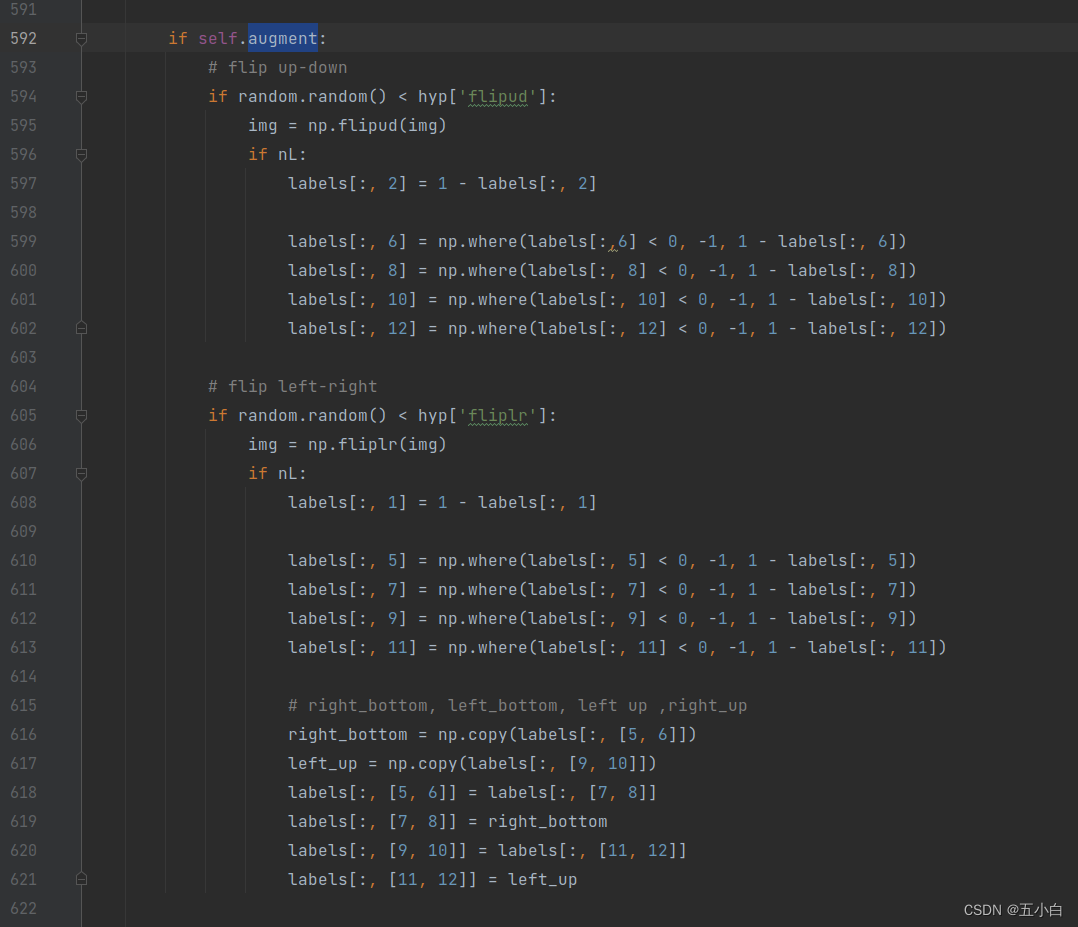
- 输入数据维度修改

2 网络结构修改
网络结构代码位于 model/yolo_plate.py
- 修改总输出维度
 每个维度输出多4个点,也就是8个输出
每个维度输出多4个点,也就是8个输出 - 网络结构修改
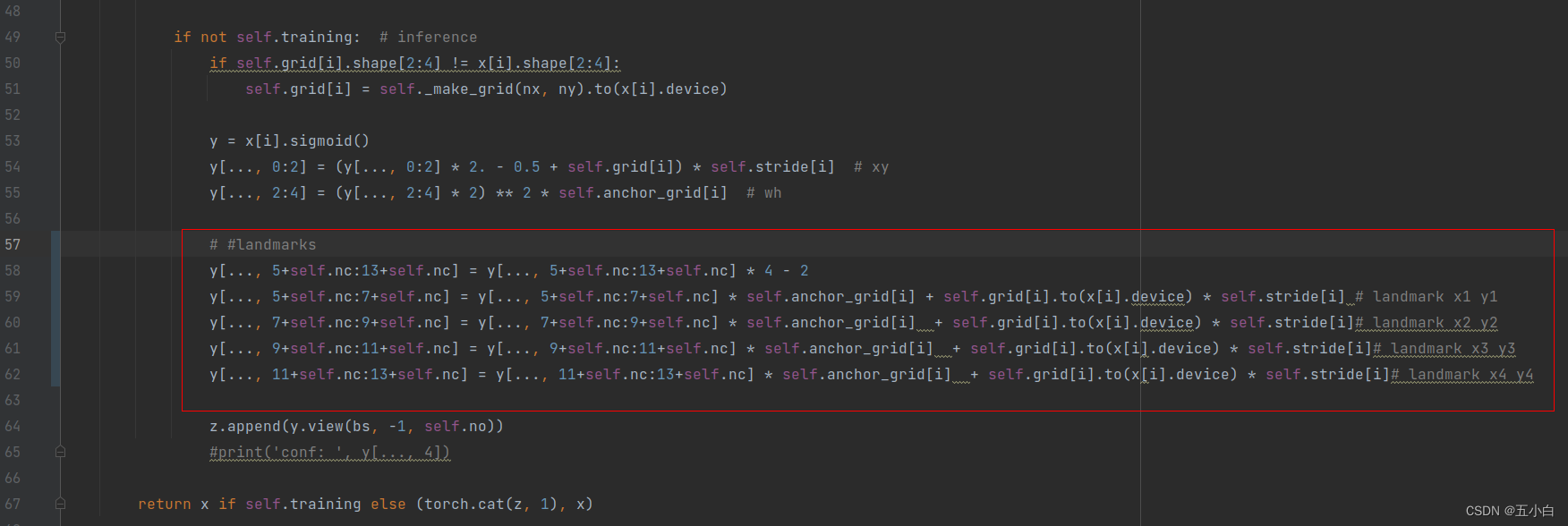 主要是确定点的输出位置,后面根据点的输出计算loss
主要是确定点的输出位置,后面根据点的输出计算loss - 完整修改代码
classDetect(nn.Module):
stride =None# strides computed during build
export =False# onnx exportdef__init__(self, nc=80, anchors=(), ch=()):# detection layersuper(Detect, self).__init__()
self.nc = nc # number of classes
self.no = nc +5+8# number of outputs per anchor
self.nl =len(anchors)# number of detection layers
self.na =len(anchors[0])//2# number of anchors
self.grid =[torch.zeros(1)]* self.nl # init grid
a = torch.tensor(anchors).float().view(self.nl,-1,2)
self.register_buffer('anchors', a)# shape(nl,na,2)
self.register_buffer('anchor_grid', a.clone().view(self.nl,1,-1,1,1,2))# shape(nl,1,na,1,1,2)
self.m = nn.ModuleList(nn.Conv2d(x, self.no * self.na,1)for x in ch)# output convdefforward(self, x):# x = x.copy() # for profiling
z =[]# inference output
self.training |= self.export
for i inrange(self.nl):
x[i]= self.m[i](x[i])# conv
bs, _, ny, nx = x[i].shape # x(bs,255,20,20) to x(bs,3,20,20,85)
x[i]= x[i].view(bs, self.na, self.no, ny, nx).permute(0,1,3,4,2).contiguous()ifnot self.training:# inferenceif self.grid[i].shape[2:4]!= x[i].shape[2:4]:
self.grid[i]= self._make_grid(nx, ny).to(x[i].device)
y = x[i].sigmoid()
y[...,0:2]=(y[...,0:2]*2.-0.5+ self.grid[i])* self.stride[i]# xy
y[...,2:4]=(y[...,2:4]*2)**2* self.anchor_grid[i]# wh# #landmarks
y[...,5+self.nc:13+self.nc]= y[...,5+self.nc:13+self.nc]*4-2
y[...,5+self.nc:7+self.nc]= y[...,5+self.nc:7+self.nc]* self.anchor_grid[i]+ self.grid[i].to(x[i].device)* self.stride[i]# landmark x1 y1
y[...,7+self.nc:9+self.nc]= y[...,7+self.nc:9+self.nc]* self.anchor_grid[i]+ self.grid[i].to(x[i].device)* self.stride[i]# landmark x2 y2
y[...,9+self.nc:11+self.nc]= y[...,9+self.nc:11+self.nc]* self.anchor_grid[i]+ self.grid[i].to(x[i].device)* self.stride[i]# landmark x3 y3
y[...,11+self.nc:13+self.nc]= y[...,11+self.nc:13+self.nc]* self.anchor_grid[i]+ self.grid[i].to(x[i].device)* self.stride[i]# landmark x4 y4
z.append(y.view(bs,-1, self.no))#print('conf: ', y[..., 4])return x if self.training else(torch.cat(z,1), x)@staticmethoddef_make_grid(nx=20, ny=20):
yv, xv = torch.meshgrid([torch.arange(ny), torch.arange(nx)])return torch.stack((xv, yv),2).view((1,1, ny, nx,2)).float()
3 loss代码修改
loss修改代码位于: utils/plate_loss.py
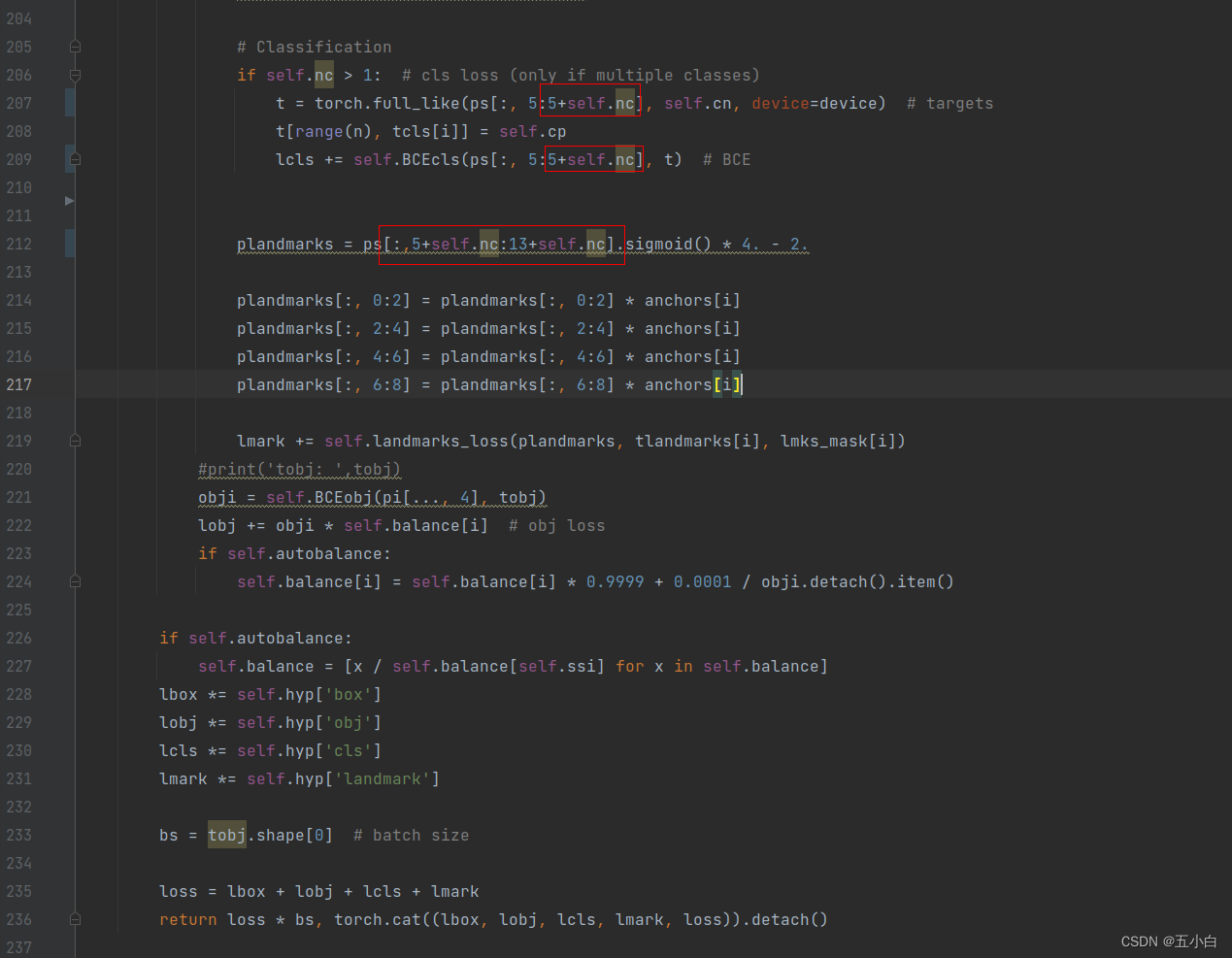
框出来的位置注意查看,代码修改主要是确定坐标点的位置,然后将坐标点进行loss计算,进行反向传播。
# 修改后的__call__代码块 :def__call__(self, p, targets):# predictions, targets, model
device = targets.device
lcls, lbox, lobj, lmark = torch.zeros(1, device=device), torch.zeros(1, device=device), torch.zeros(1, device=device), torch.zeros(1, device=device)
tcls, tbox, indices, anchors, tlandmarks, lmks_mask = self.build_targets(p, targets)# targets# Lossesfor i, pi inenumerate(p):# layer index, layer predictions
b, a, gj, gi = indices[i]# image, anchor, gridy, gridx
tobj = torch.zeros_like(pi[...,0], device=device)# target obj
n = b.shape[0]# number of targets#print('pi: ', pi.shape)if n:
ps = pi[b, a, gj, gi]# prediction subset corresponding to targets# Regression
pxy = ps[:,:2].sigmoid()*2.-0.5
pwh =(ps[:,2:4].sigmoid()*2)**2* anchors[i]
pbox = torch.cat((pxy, pwh),1)# predicted box
iou = bbox_iou(pbox.T, tbox[i], x1y1x2y2=False, CIoU=True)# iou(prediction, target)
lbox +=(1.0- iou).mean()# iou loss# Objectness
tobj[b, a, gj, gi]=(1.0- self.gr)+ self.gr * iou.detach().clamp(0).type(tobj.dtype)# iou ratio#print('tobj: ',tobj[b, a, gj, gi] )# Classificationif self.nc >1:# cls loss (only if multiple classes)
t = torch.full_like(ps[:,5:5+self.nc], self.cn, device=device)# targets
t[range(n), tcls[i]]= self.cp
lcls += self.BCEcls(ps[:,5:5+self.nc], t)# BCE
plandmarks = ps[:,5+self.nc:13+self.nc].sigmoid()*4.-2.
plandmarks[:,0:2]= plandmarks[:,0:2]* anchors[i]
plandmarks[:,2:4]= plandmarks[:,2:4]* anchors[i]
plandmarks[:,4:6]= plandmarks[:,4:6]* anchors[i]
plandmarks[:,6:8]= plandmarks[:,6:8]* anchors[i]
lmark += self.landmarks_loss(plandmarks, tlandmarks[i], lmks_mask[i])#print('tobj: ',tobj)
obji = self.BCEobj(pi[...,4], tobj)
lobj += obji * self.balance[i]# obj lossif self.autobalance:
self.balance[i]= self.balance[i]*0.9999+0.0001/ obji.detach().item()if self.autobalance:
self.balance =[x / self.balance[self.ssi]for x in self.balance]
lbox *= self.hyp['box']
lobj *= self.hyp['obj']
lcls *= self.hyp['cls']
lmark *= self.hyp['landmark']
bs = tobj.shape[0]# batch size
loss = lbox + lobj + lcls + lmark
return loss * bs, torch.cat((lbox, lobj, lcls, lmark, loss)).detach()
三 注意事项
1 训练问题,原代码没有修改val的代码,所以val的过程是错误的。
增加 non_max_suppression_landmark 方法修改val过程中nms计算
# 新建non_max_suppression_landmark 方法, 注意阅读代码后半部分文字。defnon_max_suppression_landmark(prediction, conf_thres=0.25, iou_thres=0.45, classes=None, agnostic=False, multi_label=True, labels=()):"""Performs Non-Maximum Suppression (NMS) on inference results
Returns:
detections with shape: nx6 (x1, y1, x2, y2, conf, cls)
"""
nc = prediction.shape[2]-13# number of classes
xc = prediction[...,4]> conf_thres # candidates#print('xc: ', prediction[..., 4] )# Settings
min_wh, max_wh =2,4096# (pixels) minimum and maximum box width and height
max_det =300# maximum number of detections per image
max_nms =30000# maximum number of boxes into torchvision.ops.nms()
time_limit =10.0# seconds to quit after
redundant =True# require redundant detections
multi_label &= nc >1# multiple labels per box (adds 0.5ms/img)
merge =False# use merge-NMS
t = time.time()
output =[torch.zeros((0, nc +14), device=prediction.device)]* prediction.shape[0]for xi, x inenumerate(prediction):# image index, image inference# Apply constraints# x[((x[..., 2:4] < min_wh) | (x[..., 2:4] > max_wh)).any(1), 4] = 0 # width-height
x = x[xc[xi]]# confidence# Cat apriori labels if autolabellingif labels andlen(labels[xi]):
l = labels[xi]
v = torch.zeros((len(l), nc +13), device=x.device)
v[:,:4]= l[:,1:5]# box
v[:,4]=1.0# conf
v[range(len(l)), l[:,0].long()+ nc +13]=1.0# cls
x = torch.cat((x, v),0)# If none remain process next imageifnot x.shape[0]:continue# Compute conf
x[:,5:5+nc]*= x[:,4:5]# conf = obj_conf * cls_conf# Box (center x, center y, width, height) to (x1, y1, x2, y2)
box = xywh2xyxy(x[:,:4])# Detections matrix nx6 (xyxy, conf, landmarks, cls)if multi_label:
i, j =(x[:,5:5+nc]> conf_thres).nonzero(as_tuple=False).T
x = torch.cat((box[i], x[i, j +5,None], x[i,5:13+nc], j[:,None].float()),1)# 5+nc:12+ncelse:# best class only
conf, j = x[:,5:5+nc].max(1, keepdim=True)
x = torch.cat((box, conf, x[:,5:13+nc], j.float()),1)[conf.view(-1)> conf_thres]# Filter by classif classes isnotNone:
x = x[(x[:,5:6]== torch.tensor(classes, device=x.device)).any(1)]# Apply finite constraint# if not torch.isfinite(x).all():# x = x[torch.isfinite(x).all(1)]# Check shape
n = x.shape[0]# number of boxesifnot n:# no boxescontinueelif n > max_nms:# excess boxes
x = x[x[:,4].argsort(descending=True)[:max_nms]]# sort by confidence# Sort by confidence# x = x[x[:, 4].argsort(descending=True)]# Batched NMS
c = x[:,5:6]*(0if agnostic else max_wh)# classes
boxes, scores = x[:,:4]+ c, x[:,4]# boxes (offset by class), scores
i = torchvision.ops.nms(boxes, scores, iou_thres)# NMSif i.shape[0]> max_det:# limit detections
i = i[:max_det]if merge and(1< n <3E3):# Merge NMS (boxes merged using weighted mean)try:# update boxes as boxes(i,4) = weights(i,n) * boxes(n,4)
iou = box_iou(boxes[i], boxes)> iou_thres # iou matrix
weights = iou * scores[None]# box weights
x[i,:4]= torch.mm(weights, x[:,:4]).float()/ weights.sum(1, keepdim=True)# merged boxesif redundant:
i = i[iou.sum(1)>1]# require redundancyexcept:print(x, i, x.shape, i.shape)pass# 默认输出# output[xi] = x[i]# 继续对结果后处理,提升低阈值下性能(0.4)# 用于推理,降低框的重叠# 建议训练过程注释掉681-693 会大大降低val速度
tmpx = x[i]# 同类别框相互包裹,去除低置信度,减少误检
boxes, scores = tmpx[:,:4], tmpx[:,4]
ioumin = box_iou_min(boxes, boxes)
cles = tmpx[:,-1]for class1 inrange(len(cles)):for class2 inrange(len(cles)):if scores[class1]>0.1and scores[class2]>0.1and class1 != class2 and cles[class1]== cles[class2]and ioumin[class1][class2]>0.85:# if scores[class1] > 0.1 and scores[class2] > 0.1 and class1 != class2 and ioumin[class1][class2] > 0.85:if scores[class2]> scores[class1]:
scores[class1]=0else:
scores[class2]=0
output[xi]= tmpx[scores>0.1]#outputsreturn output
修改test.py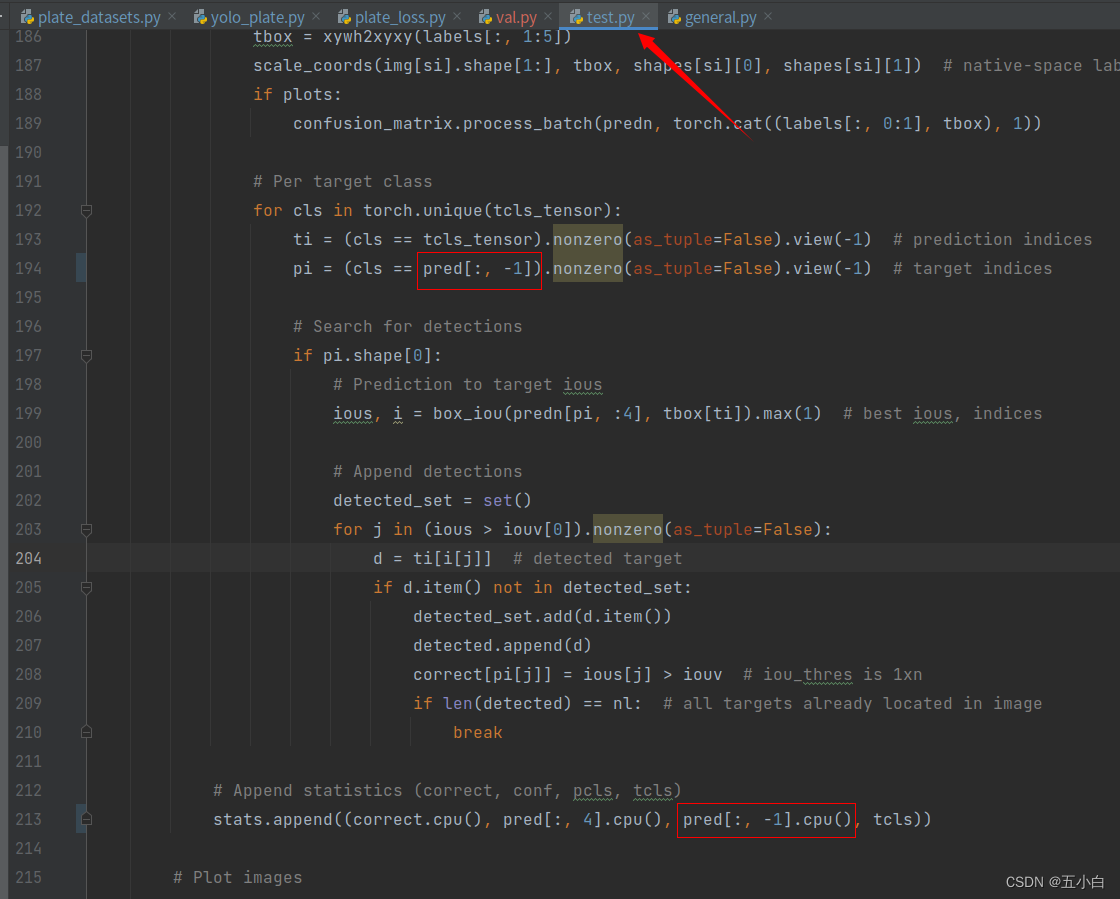
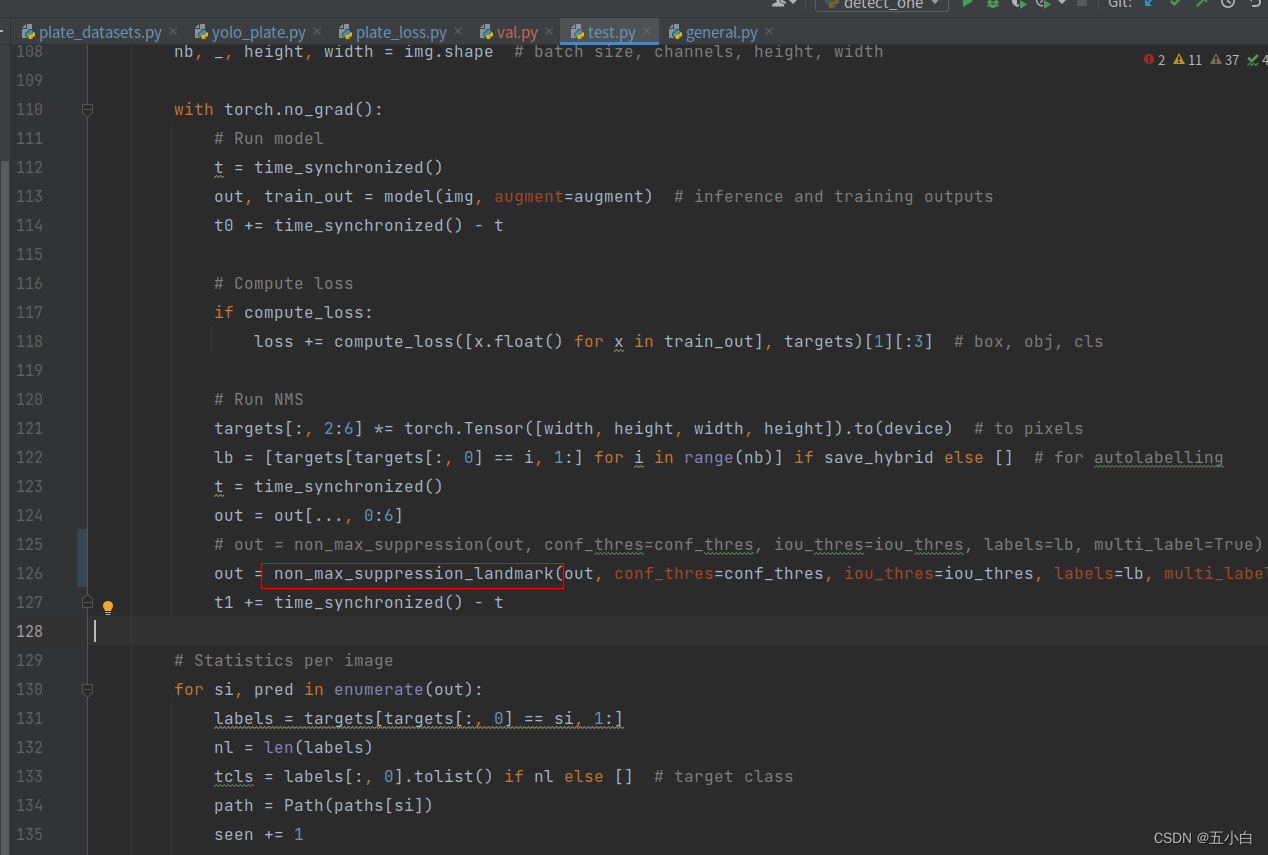
正常情况应该是不会报错,都修改完毕了~
大家可以实际动手试试,如果有问题后台私聊我哟~
后面代码整理好了,会把链接更新上来。
参考代码
yolov5-car-plate :单分类+4个点输出 ,https://github.com/xialuxi/yolov5-car-plate
版权归原作者 五小白 所有, 如有侵权,请联系我们删除。